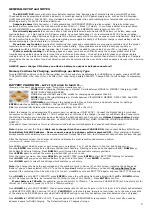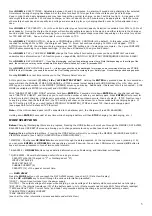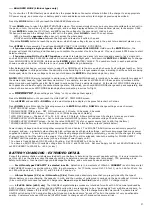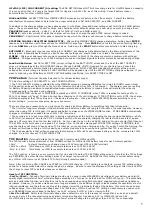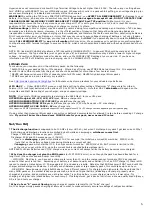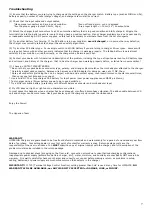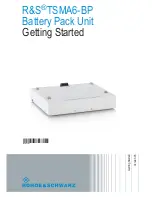
1
Hyperion NET & DUO Series 3 Chargers - User Manual
v4.6+ firmware versions. Visit http://media.hyperion.hk/dn/eos for the newest manuals, firmware, and EOS SUITE PC software
Warnings:
EOS chargers are carefully designed with many built-in safety features, such as
reverse polarity protection, input voltage error warning, and cell-count
mismatch warnings for lithium chemistry batteries. HOWEVER, IT IS THE
RESPONSIBILITY OF THE USER TO INSURE THAT THE CHARGER IS
CONFIGURED AND USED IN A SAFE MANNER IN PROPER ENVIRONMENT.
CAUTIONS
Always be sure that the charger is properly configured for the correct
battery type.
ALWAYS
power charger ON
before you attach a
battery to output or balance connectors
.
Be SURE
that your lithium battery pack balance connector matches
the multi-adapter type connected to the charger.
SYNC MODE charging should start with packs at near equal discharge
states (see more details in text)
Be sure that the batteries you charge are capable of charging at the
current (A) rate you select
Never charge batteries unattended
Charge only in a fire-resistant environment, non-flammable surfaces
such as on concrete or brick
Do not charge near easily flammable materials
Do not charge batteries inside a model
Charging outdoors is strongly recommended
Use only high-quality gold 4mm bullet connectors for charge output
cable connection to the charger. See “setup”
Properly insulate and regularly inspect all connectors to eliminate the
possibility of short circuit. Damage caused by output short circuit is
not covered by warranty.
Never allow the charger case to contact an AC/DC power supply case
while powered
Do not drop or cause other shock to the charger, nor subject it to
moisture, condensation or liquids
Do not attempt to charge battery packs made from different types of
cells, a mixture of old and new cells, or cells made with chemistry not
supported by the EOS charger
NEVER attempt to charge “non-rechargeable” cells
Do not open the case of the charger under any circumstances. Doing
so will void the warranty
Keep the charger away from children or pets at all times.
NEVER ATTEMPT TO CHARGE A SINGLE BATTERY ACROSS
BOTH PORTS of a DUO charger or 2x NET chargers.
(example:
a “single unit” 10S pack) DOING SO WILL DAMAGE THE CHARGER,
BATTERY, AND WILL VOID YOUR WARRANTY.
PUT SAFETY AHEAD OF ALL OTHER CONSIDERATIONS!
HIGH RISK CHARGING ADVISORY
Avoid charging batteries indoors. If you must charge indoors, or any place injury
or damage to property could occur in the event of fire, then be sure to:
* Keep battery well away from flammables (2 meters or more)
* Contain battery in a heavy fireproof container (such as a brick box)
* Always monitor the charge
Specifications & Features:
Built -in Hyperion LBA10/300 Balancers with 300mA max
balance rate per cell
12-bit
Resolution Balance Circuits for max accuracy
STORE MODE
for LiPo, LiFe, and LiIo allows fast and simple
charge/discharge to 60%~70% capacity for proper storage of
Lithium Batteries = long battery life
CYCLE MODE
for Lipo, Life, LiIo, NiCd, and NiMH
Built-In
DISCHARGE
function
TCS
- Terminal Capacity Selection during charge to speed
charge and/or increase battery Cycle Life
TVC
– Terminal Voltage Control for LiPo, LiFe, and PB
Rich Data Displays
via LCD display during and after charging
and balancing
USB
PC Port for Firmware upgrades, and
PC Control
& Data
Suite
Software System, which allows full control of the charger
via PC, Data Logging, Memory Management, and more.
Temperature Sensor
Ports & Temp Stop settings*
Power Supply Amperage Control
to allow reliable charging
with lower-output power supplies
Power Supply Voltage Control
works in concert with
Amperage control to insure the charger does not overload your
variable power supply
Adjustable Power Sharing
% between Outputs (DUO) when
low-output power supply is in use.
Input Cable with 4mm Male
Conn Clamps
Output Cable Set
(s) Included, with 4mm Connectors
Integral, Thermostat-Controlled Cooling Fans
16-Character, Yellow Backlit LCD Data Display(s). Highly visible
in all conditions
20 User-definable Memory Positions
per port (40 total for
DUO series). Unlimited Storage and upload of memory sets via
EOS SUITE software.
* Temp sensors available separate: #HP-EOSTMPSEN
** Firmware upgrades only available if/when improvements are
identified in future.
HYPERION ACCEPTS NO RESPONSIBILITY FOR DAMAGE OR
INJURY FOR INDOOR or other HIGH RISK CHARGING
ACTIVITY
0720i-NET3-AD 0720i-NET3 0615i-DUO3 1420i-NET3
EOS0720i-SDUO3
Charger
Output
Ports
1 1 2 1 2
Max Watts Output per port w/DC Input
150
250
180 (360 total)
550
500 (1000 total)
Max Watts Output per port w/AC Input
90
n/a
n/a
n/a
n/a
DC Input required for max watts output 13.5V+
14.5V+ 14.5V+
24V+
24V+
Max Current Output (A) per port
20
20
15
20
20
Discharge Watts Limit per port
50
80
50
80
40
Discharge Current (A) Limit per port
5
10
10
10
5
DC Input Voltage Range
10.5V~15.0V
10.5V~29.0V 10.5V~29.0V 10.5V~29.0V 10.5V~29.0V
AC>DC PS for Max Watts Output
n/a
1
14.5V+, 340W+
14.5V+, 480W+
24V+, 700W+
24V+, 1300W+
Lead-Acid DC Input Suggested
12V Deep-Cycle
24V Deep-Cycle 24V
Deep-Cycle 24V
Deep-Cycle 24V
Deep-Cycle
Max Lipo/LiFe/LiIo “S” per port
7
7
6
14
7
Max Lipo/LiFe/LiIo “S” via SYNC MODE
2
14 14 12 28 14
Max PB (lead-acid) Cells per port
12
12
12
12
12
Max NiCd/NiMH Cells per port
16
16
16
16
16
Built-In USB with included cable
yes
yes
yes
yes
yes
Charger Control/Editing via PC Software
EOS Suite
EOS Suite
EOS Suite
EOS Suite
EOS Suite
Charge Logging/Tagging via Software
EOS Suite
EOS Suite
EOS Suite
EOS Suite
EOS Suite
Firmware Upgradable
yes
yes
yes
yes
yes
Temp Sensor Port (sensor is option)
yes
yes
yes
yes
yes
1 - Net3-AD has internal AC power supply, or can be connected to DC supply instead (but not both together!). All others are DC-input only.
2 – All DUO series chargers are already internally networked for SYNC of two packs. All NET chargers can SYNC by connecting two of the same
series NET chargers together, with option cable# HP-EOS0610-MSC. For large flight packs, SYNC MODE balance charging of two SEPARATED (split)
packs can be used. After charging, the split packs are series-wired to make the flight pack, like 8S, 9S, 10S, etc…
(so 2x2S=4S up to 2x14S=28S series-wired flight packs are possible, depending on specs of the EOS charger(s) used to SYNC charge)


